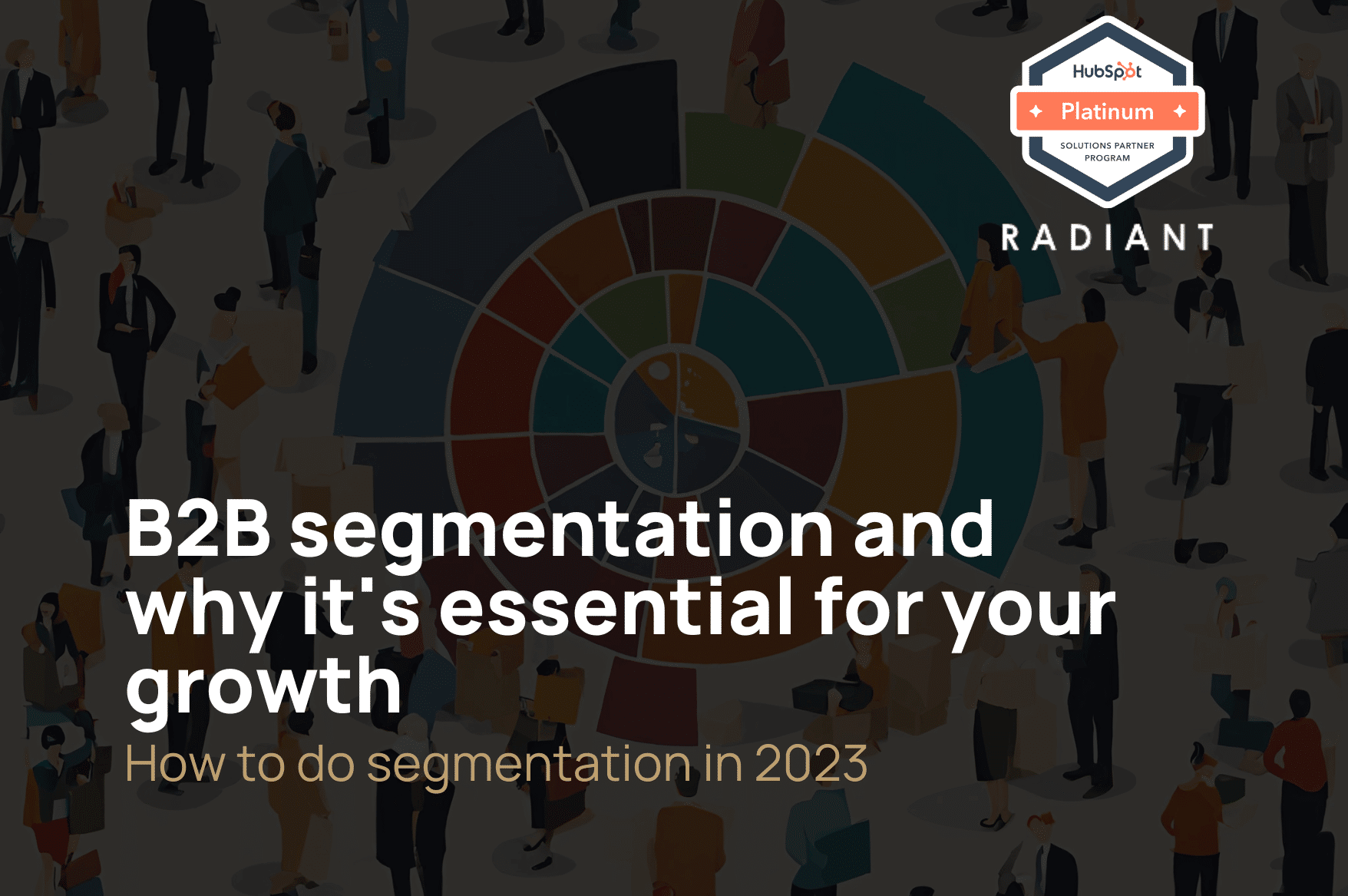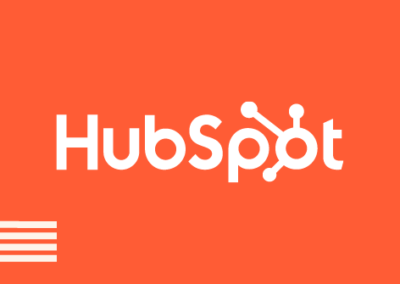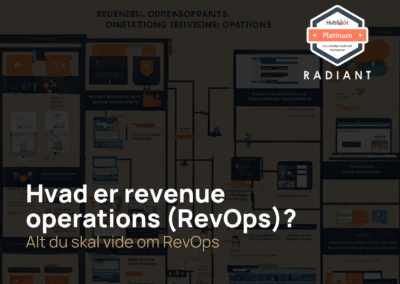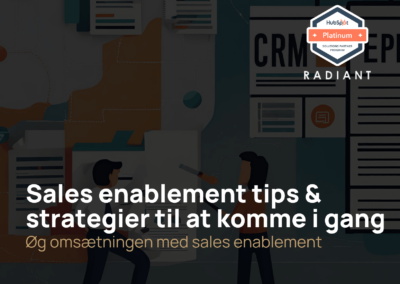B2B segmentation is about understanding the types of customers, their needs and increasing the relevance of your B2B sales. In this post, we will focus on the importance of B2B segmentation for your business growth and how you can leverage the many benefits it can bring to your marketing and sales.
What is B2B segmentation?
B2B segmentation means dividing your leads into different groups based on a variable such as position, company size or something else. This process helps categorize different business customers based on specific segmentation criteria, streamlining and optimizing your marketing and sales strategy.
B2B segmentation criteria can be created based on geography, demographics, key metrics, brackets and much more.
The importance of B2B segmentation
When talking about efficient sales processes, automation and optimization in B2B sales, segmentation is vital. It can drastically improve your business growth, by consistently hitting the best leads, you can create more precise and targeted strategies.
Imagine all the work that goes on before and after segmentation. Creating even 10% more relevance, uniqueness or precision in your message by segmenting can make a huge difference to your growth.
Benefits of B2B Segmentation
By leveraging B2B segmentation, sales and marketing efforts can be optimized so that each message is tailored to meet specific customer needs. Below are some of the benefits that come with good segmentation.
Better understanding of the target group
By setting up your segmentation criteria and segmentation of your ideal customers (ICP), you can gain a deeper understanding of your target audience and their needs (this can also be achieved by creating personas). This knowledge can help you better align your message with your customers’ unique needs and expectations, on your website, sales pitch and in your marketing. Below are some of the benefits of setting segmentation criteria and creating a segmentation:
- Identify the characteristics and needs of different groups in your target audience.
- See unique behavioural patterns among different segments, which can help create more customized and effective marketing strategies.
- Understand what types of communication and engagement work best for different groups in your target audience.
The above are general examples of some of the benefits that come with good segmentation, however, it is important to remember that businesses are different and this makes the output of segmentation vary as well as the requirements for good segmentation.
Tailored marketing messages
By using segmentation, you can create tailored marketing messages that speak directly to your customers’ unique needs based on their position or industry, their engagement with previous emails or based on how many times they’ve visited your website or something else. Below are some important considerations and tips for getting started with segmentation
- Use customer data to identify unique segments
- Use varying language and content depending on the segment
- Use a tool such as LassoX or Vainu to find relevant companies that match your segmentation criteria
Efficient resource utilization
With B2B segmentation, you can use your resources more efficiently as it provides insight into which segments are most likely to convert. It’s a fundamental part of effective resource utilization in sales and marketing.
How do you do B2B segmentation?
Performing B2B segmentation requires planning and using relevant data. The steps include data collection, data analysis, segmenting, targeting marketing efforts, and ongoing evaluation and adjustment.
Below is a step-by-step process for creating effective B2B segmentation
Collecting data about the target group
Collecting data on your target audience is an essential first step in B2B segmentation. Different collection methods are used to get a detailed view of the unique characteristics, needs and preferences of business customers.
If your segmentation needs to be built on data enrichment of key figures for annual reports, tools such as LassoX and Vainu can help you. However, if you are basing your segmentation on interactions with your website, you need to do your homework, which includes setting up a CRM system and integrating a system such as lead feeder that can measure this.
So your data collection can vary depending on how you want to segment.
Analysis of collected data
The next step in your segmentation is analyzing the segmentation. This is an important step because it can help you define customer segments, which is the next step. You need to see the connections between different data and whether you can link needs across groups. It’s all about understanding the data you collect and how you can use it to create tailored sales strategies.
Without this analysis of the collected data, your B2B segmentation can be less rewarding, as there may be several nuggets in the data that need to be uncovered, but which you can’t expect the individual salesperson to do – which is why it’s your job to do this.
Dividing the target audience into segments
Now you’re ready to divide the target audience into segments, often based on needs and the message/pitch you’re making.
A carefully segmented audience allows you to deliver more personalized and relevant campaigns. When B2B segmentation is done right, it can result in higher engagement from leads, which can ultimately help increase sales.
In B2B segmentation, a good breakdown of the target audience emphasizes that you have full insight into who their customers are and what their key needs are. This provides a better understanding of customer behavior and supports a more effective marketing strategy. Which is an essential step for the next step.
Targeting of marketing initiatives
By using B2B segmentation, marketing strategies are optimized as messages are precisely tailored to the segment in question. This can be done by tailoring VPs to your segmentation so that different industries, positions, etc. receive different VPs.
By hitting right at the heart of your target audience’s needs, engagement increases and conversion rates can see a significant improvement.
Evaluation and adjustment process
Evaluation and adjustment is a crucial factor when it comes to segmentation. Without it, it can be difficult to determine if your marketing strategies are effective and profitable.
It’s important to ask those who have customer contact whether they feel segmentation meets the goals and whether it adds value.
However, segmentation requires constant updating to ensure your marketing is relevant.
B2B segmentation techniques
A lot has happened in B2B segmentation techniques where previously the focus was on demographics and firmographics. Whereas today, by aggregating data, you can create a much more data-based segmentation. Below are some of the best segmentation techniques.
Intelligent data segmentation
‘Intelligent data segmentation’ means segmenting based on data in a smart way. This may seem vague at first, but it’s quite the opposite.
In such segmentation, you can use data from annual reports, for example, if the company mentions something about ESG, you can segment by interactions with certain pages on the website, you can segment by growth in key figures, number of new employees or open job postings.
Contact us to find out how we can help you with the above.
Demographic segmentation
By using demographic data in your B2B segmentation, you can gain key insights about your customers’ age group, occupation, gender and education level. This data can help clarify your communication and tone of voice.
Firmographic segmentation
Firmographic segmentation is an essential technique in B2B marketing. It’s about grouping companies based on specific characteristics such as industry, size, location, financial status and many more.
Behavioural segmentation
The use of behavioral parameters in B2B segmentation is to identify and understand the buying behavior of companies. It provides in-depth insights into how, when and why companies make purchases or use services.
An example of this would be tailoring your communication to the time of year when companies are most likely to be planning new projects.
Segmentation through a CRM system (HubSpot)
With HubSpot’s list segmentation, you can divide both customers and visitors to your website into segments, allowing you to tailor the experience in the sales and/or marketing process.
Customer lists are created based on various criteria that you set up yourself. You can use them to keep track of where leads are in the buyer’s journey so you can time both marketing and sales activities. Increasing the likelihood of a sale.
To give you an understanding of how you can use HubSpot for segmentation, we’ve put together a hypothetical example; you run a company that sells a payroll platform to Danish companies.
For example, you could segment based on the following criteria:
- Leads that have an address or IP address in Denmark
- Leads who work in a company with less than 500 employees
- Leads that have visited your website within the last month
- Leads that have spent a minimum of 5 minutes on the pricing landing page
- Leads who have signed up for your newsletter or downloaded specific material
The possibilities are endless. You decide which criteria you want to use for segmentation. The benefit is that your salespeople know that a lead doesn’t qualify to be contacted just because they have a Danish IP address or have visited your website within the last month. On the other hand, a lead that has visited the website multiple times, shown interest in the price list and downloaded your e-book is far enough along in the buyer’s journey for a salesperson to engage with the lead. Hence an optimized sales process.
In addition, the power of segmentation lists is that they enable you to target your marketing materials. The person who has already downloaded the e-book needs a different email flow than the person who has just visited the website for the first time. Fully automatic.
Manage your ICP efficiently with HubSpot
One way to manage your ICP is by using a customer relationship management (CRM) platform like HubSpot. HubSpot is a leading CRM platform that gives B2B companies the tools they need to manage their customer relationships and grow their business. It includes features for tracking and analyzing customer data, managing customer interactions and adapting to changing market conditions. It can be a valuable resource for companies in the SaaS, finance, professional services and technology industries during a recession.
HubSpot also offers a range of marketing and sales tools. These tools can help businesses create targeted campaigns designed to reach and engage their ICP, ultimately leading to increased sales and revenue.
All in all, having a well-defined ICP is the key to success for SaaS, financial, professional services and technology companies during a recession. By focusing its efforts on its ideal customers and tailoring its products or services to their needs, a business can maximize its return on investment, build stronger relationships with its customers and achieve greater success in a challenging economic environment. Using a platform like HubSpot can help businesses effectively manage their ICP and achieve industry-leading results.
Get an introduction to Sales as a Service
Radiant is a leader in Sales as a Service, where we have been performing Sales as a Service for our customers for the past 6 years and have delivered more than 70 million ARR. We have done this by 1) Implement a scalable CRM system that supports their needs 2) Use smart technology for segmentation and integrations for prospecting 3) Represent them by booking sales meetings, managing the pipeline and winning deals.
Get a free, no-obligation introduction to Sales as a Service.





